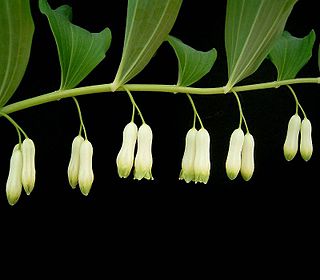
Polygonatum, also known as King Solomon's-seal or Solomon's seal, is a genus of flowering plants. In the APG III classification system, it is placed in the family Asparagaceae, subfamily Nolinoideae. It has also been classified in the former family Convallariaceae and, like many lilioid monocots, was formerly classified in the lily family, Liliaceae. The genus is distributed throughout the temperate Northern Hemisphere. Most of the approximately 63 species occur in Asia, with 20 endemic to China.

Adenophora is a genus of flowering plants in the family Campanulaceae, the bellflowers. Plants of this genus are known commonly as ladybells. Most of the species in the genus are native to eastern Asia, with a few in Europe. Many are endemic to either China or Siberia.

Zanthoxylum is a genus of about 250 species of deciduous and evergreen trees, shrubs and climbers in the family Rutaceae that are native to warm temperate and subtropical areas worldwide. It is the type genus of the tribe Zanthoxyleae in the subfamily Rutoideae. Several of the species have yellow heartwood, to which their generic name alludes. Several species are cultivated for their use as spices, notably including Sichuan pepper.
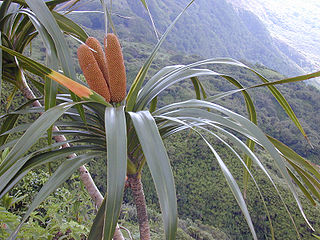
Freycinetia is one of the five extant genera in the flowering plant family Pandanaceae. The genus comprises approximately 180–200 species, most of them climbers.

Osmanthus is a genus of about 30 species of flowering plants in the family Oleaceae. Most of the species are native to eastern Asia with a few species from the Caucasus, New Caledonia, and Sumatra. Osmanthus has been known in China since ancient times with the earliest writings coming from the Warring States period; the book Sea and Mountain. South Mountain states: "Zhaoyao Mountain had a lot of Osmanthus".
William Botting Hemsley was an English botanist and 1909 Victoria Medal of Honour recipient. The standard author abbreviation Hemsl. is used to indicate this person as the author when citing a botanical name.

Dysoxylum is a genus of rainforest trees and shrubs in the flowering plant family Meliaceae. About 34 species are recognised in the genus, distributed from India and southern China, through southeast Asia to New Guinea, Solomon Islands, and Australia. The name Dysoxylum derives from the Greek word ‘Dys’ meaning "bad" referring to "ill-smelling" and ‘Xylon’ meaning "wood".
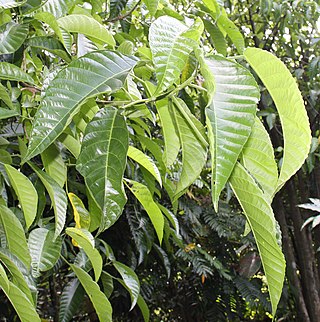
Dendrocnide is a genus of approximately 40 species of plants in the nettle family Urticaceae. They have a wide distribution across North East India, Southeast Asia, Australia and the Pacific Islands. In Australia they are commonly known as stinging trees.

Mackinlaya is a genus of flowering plants in the family Apiaceae, native to Malesia, Papuasia and Australia. It was formerly placed in Araliaceae.
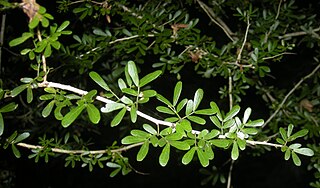
Archidendropsis is a genus of flowering plants in the family Fabaceae. It includes 11 species, which are native to Australia, New Guinea, the Bismarck Archipelago, Solomon Islands, and New Caledonia.
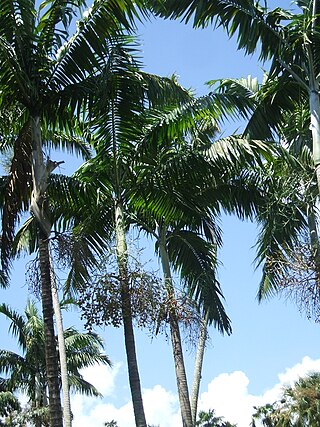
Veitchia is a genus of flowering plant in the family Arecaceae.

Anodendron is a genus of plant in the family Apocynaceae first described as a genus in 1844. It is native to most of tropical Asia: China, the Indian subcontinent, Southeast Asia, New Guinea, and some islands of the western Pacific.
Lepinia is a genus of plant in the family Apocynaceae first described as a genus in 1849. It is native to various islands in the Pacific Ocean.
- Lepinia marquisensisLorence & W.L.Wagner - Fatu Hiva in the Marquesas
- Lepinia ponapensisHosok. - Pohnpei in the Caroline Islands
- Lepinia solomonensisHemsl. - New Guinea, Solomon Islands
- Lepinia taitensis Decne. - Moorea + Tahiti in the Society Islands
Leptosiphonium is a genus of flowering plants in the family Acanthaceae. It includes ten species native to New Guinea and the Solomon Islands.
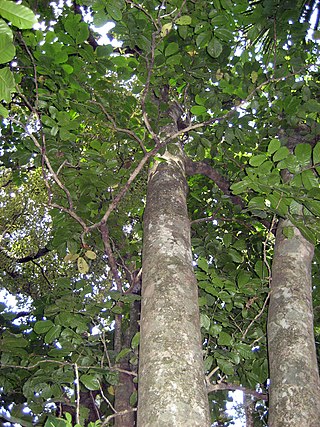
Didymocheton is a genus of flowering plants in the family Meliaceae. It includes 41 species which range from eastern India through Indochina and southern China to Malesia, Papuasia, eastern Australia, New Zealand, and the South Pacific.

Embelia is a genus of climbing shrubs once placed in the family Myrsinaceae, which is now included in the Primulaceae. There are about 130 species which occur in tropical and subtropical areas across a wide range including Africa and Madagascar and from eastern Asia to the Pacific Islands as well as Australia including:

Corynocarpus is the only genus of plants in the family Corynocarpaceae and includes five species. It is native to New Guinea, Australia, New Zealand, New Caledonia, and Vanuatu.

Sciaphila is a genus of mycoheterotrophic plants in the family Triuridaceae. These plants receive nutrition from fungi and neighboring trees and have less need for photosynthesis. It is widespread in tropical and subtropical regions, found in Africa, China, Japan, the Indian Subcontinent, Southeast Asia, Latin America and on various islands Pacific Islands. The most noteworthy feature of the genus is the number of the various flower parts 99.9 percent of Monocots are trimerous, but Sciaphila spp. can have eight or even ten parts in a whorl.
Steganthera is a genus of flowering plants belonging to the family Monimiaceae.
Merrilliodendron is a monotypic genus of flowering plants belonging to the family Icacinaceae. It has a synonym of PeekeliodendronSleumer. The only species is Merrilliodendron megacarpum(Hemsl.) Sleumer















